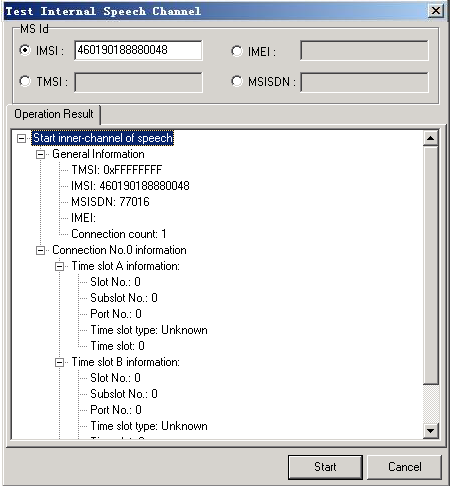This describes how to test the internal speech channel
and display the testing results. To perform this task, you need to
enter the MS ID.
Prerequisites
- The LMT runs normally.
- The communication between the LMT and the BSC is normal.
- The MS is in conversion.
Context
- After the MS ID user information is entered, the system
can detect the connection between internal voice channels occupied
by this call in the BM subrack and TC subrack of the BSC. The connection
between Ater interface EIUTs (OIUTs), however, cannot be detected.
- Testing the internal speech channel is one of the means of locating
the internal voice problems of the BSC.
Procedure
- Through GUI
- Choose to test the internal speech
channel.
- Set parameters in the MS ID area
and then click Start. The query results are
displayed, as shown in Figure 1.
 NOTE:
NOTE: - If you set the MS ID to MSISDN (you are advised to trace the calling ID through the called ID):
- If you trace the calling party, the MSISDN is the called ID, that
is, the ID that the MS calls. For example, if the MS calls 12345,
then the MSISDN is 12345.
- If you trace the called party, the MSISDN is the calling ID. The
MS must be enabled with caller ID display. If 54331 is displayed on
the MS, specify the MSISDN with 54321; if 8654321 is displayed on
the MS, specify the MSISDN with 8654321.
- If you set the MS ID to TMSI or IMSI, you must determine the reassignment
strategy on the MSC side.
- If TMSI is carried, you can test the internal speech channel of
the MS through the TMSI.
- If IMSI is carried, you can test the internal speech channel of
the MS through the IMSI.
- If you set the MS ID to IMEI, you must determine whether the IMEI is available to the MSC.
Figure 1 Testing internal speech channel

- Through MML
- Run the CHK INNSPCH command on the LMT to test the internal
speech channel.
Copyright © Huawei Technologies Co., Ltd.
